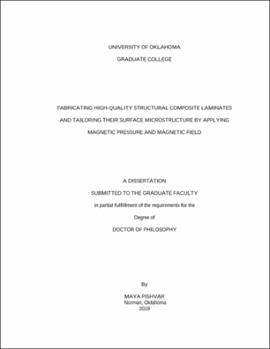| dc.description.abstract | Advanced fiber reinforced polymer (FRP) composites are widely used in structural applications due to their high specific strength and stiffness. Generally, high-quality, advanced FRP composites are produced using an autoclave. However, the disadvantages associated with autoclave curing include high initial capital investment and operating costs. As a result, there is an increasing interest in the development of out-of-autoclave (OOA) techniques to produce composite parts with comparable properties to those obtained in an autoclave, but at a lower cost. In the first part of this dissertation, a novel technique, magnet assisted composite manufacturing (MACM), is developed to produce high-quality FRP composite laminates out of an autoclave. In this technique, high-temperature permanent magnets are utilized to apply sufficiently high consolidation pressure during cure of laminates. To establish MACM as a viable OOA method for producing structural composite laminates, the microstructure and properties of laminates fabricated by MACM are compared with those cured in an autoclave. The high flexural properties, fiber volume fraction of over 60% with less than 1% voids of the laminates fabricated by MACM revealed the potential of this process to be used as a lower-cost alternative to autoclave cure, without diminishing the quality of the part.
Despite the favorable mechanical properties of FRP composite materials, their non-mechanical properties, e.g., thermal or electrical conductivities still is a major concern, limiting their application. It is well-known that incorporation of a third phase into structural composite laminates is quite effective in improving multiple non-mechanical properties. The second part of the dissertation involves the development of a novel cascaded suspension deposition method to introduce well-dispersed short fibers into the molded laminates, allowing the control of the surface properties of the resulting laminates. Towards this goal, the three-phase composite laminates are fabricated first by depositing short nickel coated carbon (NiC) fibers on a glass fabric surface by the proposed method and then followed by vacuum infusion. To demonstrate the effectiveness of this technique, the microstructure morphology of the deposited fabric and the resulting composite is quantitatively characterized. The findings suggest that with this technique, short fibers are distributed on the laminate surface with a uniform fiber volume fraction and excellent dispersion with random orientation.
Controlling the orientation and alignment of the third phase in three-phase composite laminates is an effective approach for tailoring the anisotropy, and thus improving the functionalities of structural composites. The third part of the dissertation introduces a new magnetic‐field assisted composite processing method to induce alignment of short fibers on the surface of three-phase composite laminates. For this purpose, magnetic field generated by permanent magnets are utilized to align NiC fibers in three ways: (i) during deposition of fibers by cascaded suspension deposition, (ii) on the deposited fabric after mold filling in VARTM, and (iii) on the deposited fabric during deposition, mold filling, and after mold filling. The degree of alignment and the required field strength are evaluated as a function of NiC fiber length and nickel coating thickness. The results suggest that with the proposed method, it is possible to obtain an anisotropic distribution of fibers while maintaining the uniform fiber volume fraction and good dispersion throughout the surface of the laminate. Thus, the proposed method allows tailoring surface anisotropy, thus improving the required properties in the desired direction for high-performance and other applications of FRP composites. | en_US |
